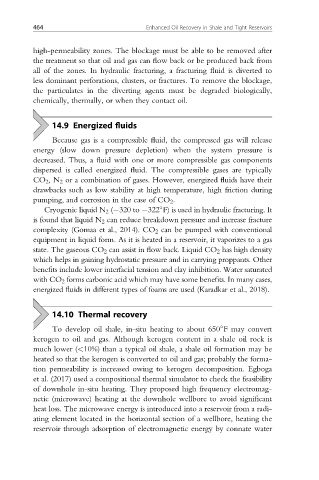Page 500 - Enhanced Oil Recovery in Shale and Tight Reservoirs
P. 500
464 Enhanced Oil Recovery in Shale and Tight Reservoirs
high-permeability zones. The blockage must be able to be removed after
the treatment so that oil and gas can flow back or be produced back from
all of the zones. In hydraulic fracturing, a fracturing fluid is diverted to
less dominant perforations, clusters, or fractures. To remove the blockage,
the particulates in the diverting agents must be degraded biologically,
chemically, thermally, or when they contact oil.
14.9 Energized fluids
Because gas is a compressible fluid, the compressed gas will release
energy (slow down pressure depletion) when the system pressure is
decreased. Thus, a fluid with one or more compressible gas components
dispersed is called energized fluid. The compressible gases are typically
CO 2 ,N 2 or a combination of gases. However, energized fluids have their
drawbacks such as low stability at high temperature, high friction during
pumping, and corrosion in the case of CO 2 .
Cryogenic liquid N 2 ( 320 to 322 F) is used in hydraulic fracturing. It
is found that liquid N 2 can reduce breakdown pressure and increase fracture
complexity (Gomaa et al., 2014). CO 2 can be pumped with conventional
equipment in liquid form. As it is heated in a reservoir, it vaporizes to a gas
state. The gaseous CO 2 can assist in flow back. Liquid CO 2 has high density
which helps in gaining hydrostatic pressure and in carrying proppants. Other
benefits include lower interfacial tension and clay inhibition. Water saturated
with CO 2 forms carbonic acid which may have some benefits. In many cases,
energized fluids in different types of foams are used (Karadkar et al., 2018).
14.10 Thermal recovery
To develop oil shale, in-situ heating to about 650 F may convert
kerogen to oil and gas. Although kerogen content in a shale oil rock is
much lower (<10%) than a typical oil shale, a shale oil formation may be
heated so that the kerogen is converted to oil and gas; probably the forma-
tion permeability is increased owing to kerogen decomposition. Egboga
et al. (2017) used a compositional thermal simulator to check the feasibility
of downhole in-situ heating. They proposed high frequency electromag-
netic (microwave) heating at the downhole wellbore to avoid significant
heat loss. The microwave energy is introduced into a reservoir from a radi-
ating element located in the horizontal section of a wellbore, heating the
reservoir through adsorption of electromagnetic energy by connate water

